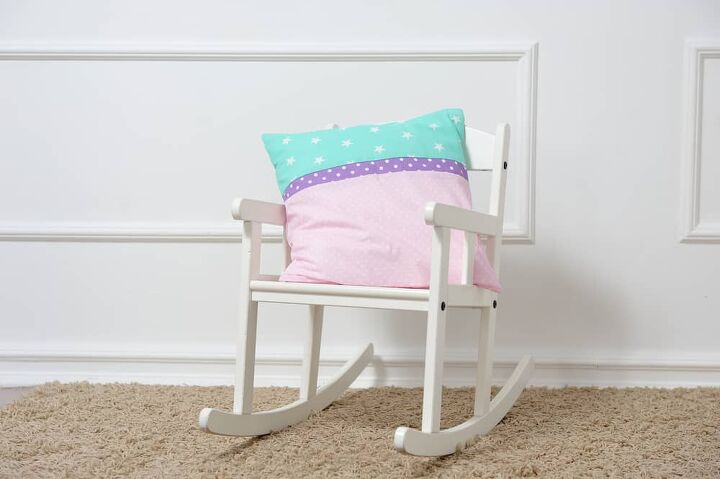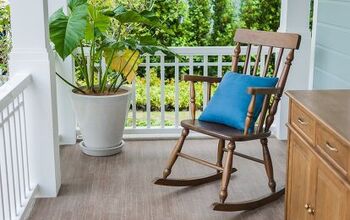Child's Rocking Chair Plans (with Drawings)

A common article of furniture that we often forget about is the rocking chair. Some may even associate childhood memories of rocking back and forth in their own rocking chair with parents or grandparents.
Children’s rocking chairs come in sizes child, junior, and youth. The child-size rocking chair is 17 inches wide by 18.5 inches in diameter by 23 inches high. Child-size rocking chairs measure 9.5 inches of space between the arms.
What Are the Dimensions for a Child’s Rocking Chair?
Children’s rocking chairs typically come in three sizes: child, junior, and youth, but they can vary based on brand. The smallest rocking chair is child-size, measuring 17 inches wide by 18.5 inches in diameter by 23 inches high. In addition, child-size rocking chairs have 9.5 inches of space between the arms.
A junior-size rocking chair measures 22 inches wide by 24 inches in diameter by 29.5 inches high. Junior-size rocking chairs have 12.5 inches of space between the arms.
A youth-size rocking chair is the largest rocking chair for children. It measures 25.5 inches wide by 27.5 inches in diameter by 33.75 inches high. These chairs have 14.5 inches of space between the arms.
How Much Space Does a Rocking Chair Need?
You should place rocking chairs two to three feet from other items and walls. This ensures there is enough room in front of and behind the rocking chair to rock back and forth. A patio or porch 10 square feet can accommodate three to four rocking chairs comfortably.
How Long Should the Rockers be on a Rocking Chair?
Rockers are typically equal to the horizontal distance from the top of the chair back to the front edge of the seat. Then, add three inches. Rockers installed on a rocking chair have two inches of overhang at the rear of the rockers, one inch in front.
Are Children’s Rocking Chairs Safe?
Overall, children’s rocking chairs are safe. However, as with most child-geared products, you should use common sense rules for safe use. When your child is rocking in the chair, supervise them to ensure they don’t fall or injure themselves.
Making sure to anchor the chair to the ground correctly is also appropriate. This can ensure the chair won’t flip over or fall on top of the child.
Styles of Rocking Chairs and Dimensions
With modern-day building and new materials, traditional rocking chairs are no longer the only rocking chair type on the market. New functionalities and building methods have resulted in a wide variety of rocking chair styles.
Here are the most popular rocking chair designs and dimensions to best suit your needs.
Traditional Rocking Chair
The most common and familiar type of rocking chair is the traditional rocking chair. Traditional rocking chairs are usually characterized by curved legs that serve as the tools that rock the chair back and forth. The downside of these chairs is that they are rigid, inflexible, and usually need a lot of floor space for functionality.
Traditional rocking chairs usually measure 37 to 45 inches tall, 26 to 30 inches wide, and 32 to 37 inches deep. Traditional antique rocking chairs can range from $100 to $3,500 or more, depending on the condition.
Glider Rocking Chair
Another common type of rocking chair is the glider rocker. The glider is more complex than traditional rocking chairs. Glider rockers use levers and hinges to rock back and forth on a flat plane rather than a traditional arc.
Glider rocking chairs take up less space than traditional rocking chairs and some say they are more comfortable. However, due to the complex design, glider rockers are more expensive and more prone to breaking. Basic, wood-frame gliders can run from $130 to $450, but upholstered glider chairs can run for $160 to $680.
Glider rocking chairs are typically 25 inches wide by 28 inches deep by 40 inches high. The seat depth is 18 inches, the seat height is 19 inches, and the seat width is 18 inches. The arm height is 24.5 inches.
Spring Rocking Chair
Spring rocking chairs are a combination of a traditional rocking chair and a glider rocking chair. They rock back and forth like traditional rockers, but mounted springs support them and cause the rocking motion.
Spring rocking chairs are durable and typically in the middle price point of traditional rockers and glider rockers. Children’s platform spring rockers measure approximately 22 inches high by 20 inches wide and 19 inches front to back.
Swivel Rocking Chair
Swivel rocking chairs utilize a mechanism that allows for rocking on more than one plane of motion. Swivel rocking chairs can also apply to gliders or spring rockers. Swivel rockers have increased comfort and flexibility but also increased price and increased risk of breakage.
Swivel rocking chairs measure 27 inches wide by 37 inches high. The seat height is 18 inches and the seat width is 17.5 inches. Swivel rocking chairs vary in price from $250 to over $3,000.
Reclining Rocking Chair
Reclining rocking chairs function exactly as their name states. These rockers allow you to recline the back of the chair. These are particularly popular for those fond of lounge chairs but also want the function of a traditional rocking chair.
Reclining rocking chair functionalities cannot function at the same time, for safety’s sake. This design also makes reclining rocking chairs more expensive than other rocking chairs. Reclining rocking chairs can range from $700 to $1,400.
Reclining rocking chairs measure 32 inches wide by 33.5 inches deep by 37.5 inches high. The seat depth is 19.5 inches, the seat height is 17.5 inches, the seat width is 16 inches. The arm height is 22 inches.
How to Choose the Right Rocking Chair Materials
Rocking chairs come in a variety of materials. When it comes to choosing the right materials, you should keep in mind these factors:
- Durability
- Maintenance
- Appearance
- Comfort
- Weight
- Price
Pine and Other Soft Woods
Pine and other soft woods are popular materials for crafting rocking chairs because they are abundant and inexpensive. However, softwoods don’t tend to weather well. They aren’t resilient, durable, and are easily scratched or dented.
To protect a rocking chair made of softwood, it must be varnished if it’s going to stay outside. Softwood rocking chairs typically have to be restrained or revarnished on a semi-regular basis as the elements can cause wear.
Oak and Other Hard Woods
Hardwoods are typically a better choice than softwoods for rocking chairs because they are resilient and durable. Like softwoods, they need to be regularly maintained to look their best, especially if they stay outside. Hardwood is moderately expensive.
Hardwood rocking chairs are more resilient to the elements and wind but will need to be restrained or revarnished regularly.
Teak
Teak is one of the best woods for outdoor furniture as it produces its own oil. This allows it to be durable and resilient material that isn’t easy to dent or scratch. In addition, it’s completely resistant to wind, water, and rust.
Teak is challenging to maintain because you need to rub it regularly to avoid silver patina, or turning grey. Teak is one of the most expensive options for outdoor rocking chairs.
Wicker
Wicker was most popular in the mid 18th century but still popular today. Wicker rocking chairs can be a good material for inside rocking chairs, but there is no durability for outdoor use.
Wicker is very light and vulnerable to wind gusts, so it can lose its appearance quickly. Wicker is also difficult to maintain. The way wicker is woven means that it’s susceptible to dirt getting stuck in the gaps.
High-Density Polyethylene
High-density polyethylene is a synthetic resin for building solid, high-quality outdoor furniture. It comes at a higher cost, but its comfort and resilience make up for it. High-density polyethylene is also easy to maintain; you can wipe it down with a cloth and soapy water.
High-density polyethylene rocking chairs can stay outside all year round due to their sturdiness and resistance to wind. High-density polyethylene is also recyclable, often made from milk jugs or shampoo bottles.
What Are the Benefits of Using a Rocking Chair
Sitting in a rocking chair is relaxing and calming, but there are also several benefits to rocking back and forth.
Here are a few health benefits of using a rocking chair.
Ease Anxiety and Dementia
The repetitive motion of rocking back and forth in a rocking chair is believed to help ease anxiety and dementia. In one study, rocking for an average of 100 minutes reduced anxiety in adults 72 to 95 by one-third. It also reduced tension, depression and patients requested less medication.
People who rocked overzealously improved their balance due to stimulating the vestibular system, the inner ear, that helps maintain balance.
Help Recover from Surgery
Rocking in a rocking chair can also potentially ease lower back pain, constipation, and abdominal pain after cesarean sections. Surgery causes stress to the body, but rocking in a rocking chair calms this response.
Increased Mobility
The light exercise that occurs when using a rocking chair can actually burn calories. It can also improve knee extension and strengthen hand muscles, leading to increased mobility.
Manage Chronic Pain
Research shows that women with fibromyalgia reduced their pain when they rocked in a rocking chair. Rocking in a rocking chair for 10 minutes, three times a week for 16 weeks, helped manage chronic pain.
Relieve Pain During Labor
Rocking in a rocking chair can also help pain experienced during child labor. According to a French study of 50 women rocking in a rocking chair had an average pain score of 6/10. Lying down or sitting had an average pain score of 8/10.
Related Questions
How do you paint a child’s rocking chair?
When painting a child’s rocking chair, you will need to use latex paint. Begin the process of painting the rocking chair by first sanding the surface. Do this outside so that sawdust doesn’t fly around the house. Next, paint the rocking chair, applying the paint in a sweeping motion to get an even coat. Finally, let the paint dry, then apply a clear spray coat to seal the rocking chair. Chalk paint is another option when painting furniture as there is little to no prep work.
How much does it cost to refinish a rocking chair?
Refinishing furniture is typically a practical option, but refinishing a rocking chair can be complex. Therefore, the task normally ranges from $200 to $500. This is more expensive than refinishing a basic dining seat. The price range to refinish a rocking chair is the same, whether the chair is wicker or wood.

Stacy Randall is a wife, mother, and freelance writer from NOLA that has always had a love for DIY projects, home organization, and making spaces beautiful. Together with her husband, she has been spending the last several years lovingly renovating her grandparent's former home, making it their own and learning a lot about life along the way.
More by Stacy Randall































